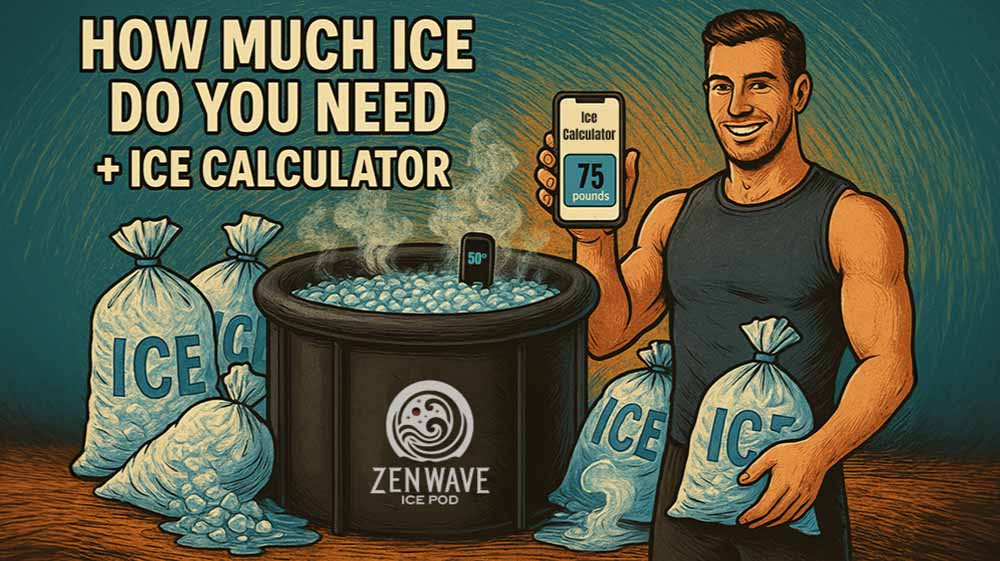Figuring out how much ice to use in your ice bath shouldn’t feel like a mystery—but it does for most people. And that’s exactly why so many plunges fall flat.
Too warm. Too short. Not enough of a shock. You walk away feeling damp and mildly refreshed—but miss out on the actual benefits cold exposure can trigger: faster recovery, nervous system resets, mental edge.
That usually comes down to one thing: you didn’t use enough ice.
In this guide, you’ll get everything you need to fix that. You’ll learn how to calculate the exact amount of ice based on your tub size and water temperature. You’ll get a breakdown of how the math works, what factors affect how much ice you need, and ways to make your setup more efficient—whether you’re hauling bags from the store or upgrading to a water chiller.
How to Calculate How Much Ice for an Ice Bath
Let’s cut straight to the numbers.
To cool water by about 20°F, you need roughly 2.5 pounds of ice for every gallon of water in your tub. That’s not a random guess—it’s based on the energy required to lower water temperature, the latent heat of melting ice, and how dense ice is compared to water (roughly 92%).
So, if you’ve got a 50-gallon tub and you want to drop the water from 70°F down to 50°F, you’ll need about 125 pounds of ice.
Here’s a full chart with pre-calculated values so you can get a quick estimate:
| Tub Size | Water Volume (Liters) | Ice Needed (lbs) | Ice Needed (kg) |
|---|---|---|---|
| 30 gal | 113.6 L | 77 lbs | 35 kg |
| 40 gal | 151.4 L | 103 lbs | 47 kg |
| 50 gal | 189.3 L | 129 lbs | 59 kg |
| 60 gal | 227.1 L | 154 lbs | 70 kg |
| 70 gal | 264.9 L | 180 lbs | 82 kg |
| 80 gal | 302.8 L | 206 lbs | 94 kg |
| 90 gal | 340.7 L | 231 lbs | 105 kg |
| 100 gal | 378.5 L | 257 lbs | 117 kg |
| 110 gal | 416.3 L | 283 lbs | 128 kg |
| 120 gal | 454.2 L | 308 lbs | 140 kg |
These numbers assume a 20°F drop from typical tap water (around 70°F). If your water starts warmer, you’ll need more ice. If it starts colder—or it’s winter—you might get away with less.
Ice Bath Calculator: How Much Ice for Your Cold Plunge Setup
Don’t want to memorize ratios or crunch the numbers every time? Use our free ice calculator.
Just plug in:
- Your tub volume (in gallons or liters)
- The current water temperature
- Your target plunge temperature
- Ambient air temperature
- Tub insulation level
It instantly calculates the total pounds and kilograms of ice you need—and even tells you how many 10 lb bags that adds up to.
This tool removes the guesswork. No more wasting money by overfilling. No more ineffective plunges from under-icing.
Based on your tub size, starting/target temps, air temp, insulation, and session time.
Run your numbers, then read on to learn why your ice needs change and how to optimize them.
Why the Right Ice Amount Actually Matters
If you’re off by 20 or 30 pounds, you might think, “Eh, close enough.” But with cold therapy, precision matters. Here’s why:
1. You Need the Right Temp to Get the Real Benefits
Cold immersion works best in the 39–55°F range. Below that gets sketchy. Above that? The effects start fading fast.
At 50–55°F, you’ll get improved circulation, inflammation reduction, and a nice dopamine boost. At 45–50°F, you trigger stronger physiological responses—like norepinephrine release, metabolic adaptation, and mental resilience.
If your plunge never gets below 60°F, you’re just taking a cold soak.
Not sure where to start? Here’s a breakdown of the most effective cold plunge temperatures by goal.
2. It Saves Time (and the Experience)
Nobody wants to pause mid-plunge to dump in more ice. Starting with the right amount means a smooth, uninterrupted session.
3. It Makes Your Routine Repeatable
Consistency is everything. If you want long-term results, you need a repeatable process. Knowing your ice needs removes friction.
4. It Cuts Waste
Ice isn’t free. Overshooting costs money. Undershooting costs your results. Nailing your quantity every time gives you more for less.
Factors That Affect How Much Ice You Actually Need
Not every plunge requires the same amount of ice. The math gives you a solid baseline—but if you want a consistently cold and efficient setup, here’s what you need to factor in:
- Tub Volume: Obvious but important. More water = more ice. Know your tub’s real capacity in gallons or liters.
- Starting Water Temperature: Cold tap water in winter might come out at 50°F. In summer? More like 70°F+. That starting point massively impacts how much ice you need.
- Target Water Temperature: Want to drop it to 55°F? Or are you going full send at 39°F? The deeper the chill, the more ice it takes.
- Ambient Air Temperature: If you’re plunging outside in the cold, your ice lasts longer. On a hot patio in July? Expect rapid melt.
- Tub Insulation: A well-insulated tub holds temperature longer. Thin plastic or metal walls bleed cold fast.
- Plunge Duration: A 3-minute dip needs less ice staying power than a 15-minute soak. The longer you’re in, the more you’ll need to maintain your temp.
- Water Cleanliness: Contaminants, debris, or even old additives can interfere with cooling efficiency. Be sure to check out our guide on keeping your cold plunge water clean and safe between sessions.
All of this is why the calculator matters. It balances these inputs and gives you a number you can trust.
Make Your Ice Colder for a Stronger Ice Bath
Not all ice is equally cold. That might sound dumb—but it’s true. Most people use fresh-made cubes straight from the freezer, which are often just at or barely below 32°F.
But your freezer doesn’t stop there. Leave those cubes in for an extra 24–48 hours, and they’ll chill down to the actual freezer temp—often around 0°F. That makes a huge difference.
Colder ice absorbs heat faster. It takes longer to melt. And it hits harder when you add it to the water.
So if you’re prepping your own ice, plan ahead. Rotate trays early. Store it in bulk. The longer it sits, the stronger it gets.
Where to Buy or Make Ice for Ice Baths in Bulk
Cold plunging on a regular basis? You’ll need a consistent ice source. Here’s how to make it sustainable:
- Buy Commercial Ice in Bulk: Many gas stations, convenience stores, or ice depots offer bulk deals—especially if you buy 50+ lbs at a time. Some will even deliver.
- Invest in a High-Output Ice Maker: If you plunge daily, this pays for itself. Look for machines that do 45–75 lbs per day. You can find countertop or standalone versions based on space.
- DIY Freezer Stash: Use large silicone block molds or fill zip-top bags. Rotate batches daily. Over a week, you can stockpile 100+ lbs in a standard freezer. For a full breakdown of techniques, check out our guide on the most efficient ways to make ice at home without commercial equipment.
- Talk to Local Restaurants or Markets: Some places toss their leftover ice at the end of the day. Ask around—they might be happy to give it away.
The key is consistency. Once you’ve nailed your ideal ice load, having a reliable source turns this into a sustainable routine.
Ice Bath Chillers vs Ice: When to Upgrade
If you’re plunging multiple times a week—or just sick of lifting 10 lb bags every session—it might be time to upgrade to a water chiller.
These units recirculate your tub water through a chiller, dropping it to your exact desired temperature and holding it there.
Here’s why that’s game-changing:
- Precision: Dial in 50°F and hold it there all day, every day.
- Convenience: No ice runs. No melting. Just chill on demand.
- Efficiency: Most models chill 50–100 gallon tubs in a few hours.
- Cleanliness: Built-in filters help keep your water fresh longer.
Yes, the upfront cost is higher. But if you’re plunging regularly, it saves time, money, and effort long term.
Final Word: Get Colder, Smarter
Your ice bath is only as effective as the water temperature. And that temperature depends entirely on how much ice you use—or how cold you can make it.
Figure out your ideal temp. Use the calculator. Stock your ice in advance—or upgrade to a chiller and never think about bags again.
Either way, don’t leave it to chance. Cold therapy works—if you do it right.

